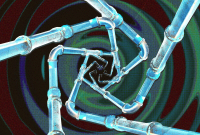Support strong Canadian climate journalism for 2025
This story was originally published by The Guardian and appears here as part of the Climate Desk collaboration.
Scientists are “increasingly concerned” by the health impact of air pollution produced by the wear of vehicle tires. The particles are especially damaging due to the toxic chemicals they are made from, say the scientists from Imperial College London.
The warning follows U.K. government data that shows significantly more tiny pollution particles now come from tire erosion than are emitted from vehicle exhausts.
The report estimates 52 per cent of all the small particle pollution from road transport came from tire and brake wear in 2021, plus a further 24 per cent from abrasion of roads and their paint markings. Just 15 per cent of the emissions came from the exhausts of cars and a further 10 per cent from the exhausts of vans and HGVs.
However, trials of new types of tires sponsored by Transport for London (TfL) found they could result in up to 35 per cent less emissions. The EU is also due to regulate t-re emissions in a world first, with new standards due to be in force by mid-2025.
Exhaust emissions from U.K. vehicles have fallen by 90 per cent since 1996, according to the government data, owing to stricter standards being enforced. As a result, the particles from tires, brakes and roads have become the main cause of pollution from traffic, presenting a new frontier in efforts to reduce levels of dirty air.
Small particles separate from tires as cars travel, become airborne and can be inhaled deep into the lungs. Air pollution causes 26,000 to 38,000 early deaths a year in England and particle pollution has been linked to a wide range of diseases. Larger particles of tire wear are washed or blown into rivers and seas and are a significant component of the plastic pollution that has contaminated both people’s bodies and the planet, from the summit of Mount Everest to the deepest oceans.
The Imperial College London report says six million tonnes of tire wear particles are released globally each year. In London alone, it says, 2.6 million vehicles emit about 9,000 tonnes of particles annually.
The particles may contain toxic chemicals including polyaromatic hydrocarbons and benzothiazoles, and heavy metals such as zinc and lead, the scientists said. But research on tire wear and its effects had been neglected compared with work on fuel emissions, they said.
“Tire wear particles pollute the environment, the air we breathe and the water runoff from roads,” said Dr. Zhengchu Tan at Imperial’s department of mechanical engineering. “Even if all our vehicles eventually become powered by electricity instead of fossil fuels, we will still have harmful pollution from vehicles because of tire wear.”
Prof. Terry Tetley, at Imperial’s National Heart and Lung Institute, said: “We are growing increasingly concerned by the impact of tire wear on human health. Simply walking on the pavement could expose us to this type of pollution. It is essential that we better understand the effect of these particles on our health.”
The Imperial team urged policymakers and scientists to embark on ambitious research on tire wear, including solutions such as better tires, devices that could capture particles and ways to incentivize public transport, cycling and walking. They also called for tighter limits on the harmful chemicals used in tires.
Tests reported in June found that in the most modern cars, almost 2,000 times more particle pollution could be produced by tire wear than was pumped out of their exhausts. A specific chemical used in tires has been linked to salmon deaths in the U.S., and California has proposed a ban.
A new type of tire, designed by the startup company Enso specifically for electric vehicles (EVs) and to produce less tire wear, was tested recently in a six-month trial sponsored by TfL and using dozens of vans operated by Royal Mail and the delivery company DPD.
The results showed that Enso’s tires produced less t-re pollution and were more energy efficient than budget range tires, meaning greater range per battery charge. They were also equal to or better than premium tires, and the company said they would cost 10 per cent less.
Rikesh Shah of TfL said: “We’re pleased to see this promising new data and are excited to see how the market responds.”
Enso’s chief executive, Gunnlaugur Erlendsson, said Enso’s tires wore more slowly because they used higher grade materials and were designed specifically for electric vehicles, which can be heavier and apply higher torque to the wheels. He said they would cost less because the company planned to sell them directly to drivers, rather than via garages. The U.K. government is an investor in the company, which has raised £5 million to date.
“We don’t want to have EVs on the roads in the future and still be suffering from air pollution,” said Erlendsson. “We want to enable EVs to be better — more range, less pollution.”
A spokesperson for the Department of Environment, Food and Rural Affairs said: “Across government, we are conducting research and supporting the development of international legislation to better understand the scale and impacts of non-exhaust emissions, including automobile tire and brake wear.”






Comments
Particulate is becoming a major problem and like micro plastic particles. You don't want to know what's in them. Like the propane from Zambonis in ice arenas, they all cause breathing problems and as they circulate in our blood we have little idea what issues they cause
None of the above applies to Canada: we have increased our tail-pipe emissions, not reduced them by 90%.
Our most populous province (with probably more tire-miles than any other) no longer requires regular tail-pipe emissions testing, more people drive cars, there are more SUVs and I'd wager also more transport truck and heavy-duty equipment traffic.
The pretty much the only kind of air pollution that has been a publicized concern in Canada has been particulates of one sort or another: the gaseous ones have received short shrift when it comes to media and public awareness.
They off-gas from various synthetic materials, especially solvents and glues, preservatives, binders, pesticides, agricultural chemicals generally (including animal feed and fertilizers), laundry and other cleaning aids, additives to fuels and water, and the list goes on and on and on. Do you remember when the water from your kitchen tap didn't smell like a heavily chlorinated swimming pool? When soap was soap, not a toxic mess of detergent, binders, extenders, whiteners, brighteners, synthetic scent, "grease lifters" and emulsifiers, lubricants, surfactants, "rinsing agents," etc.?
Many substances in common, everyday use, are known to be toxic to humans in a long list of ways. Governments have been in the habit of weighing their "economic benefits" against harms to plant and animal life, including of humans, in a bizarre cost-benefit analysis. Human health and life are apparently not all that weighty when considered against corporate profits. And after all, "treating" the (sometimes incurable) illnesses that result add to GDP, so there's no downside that matters, right?